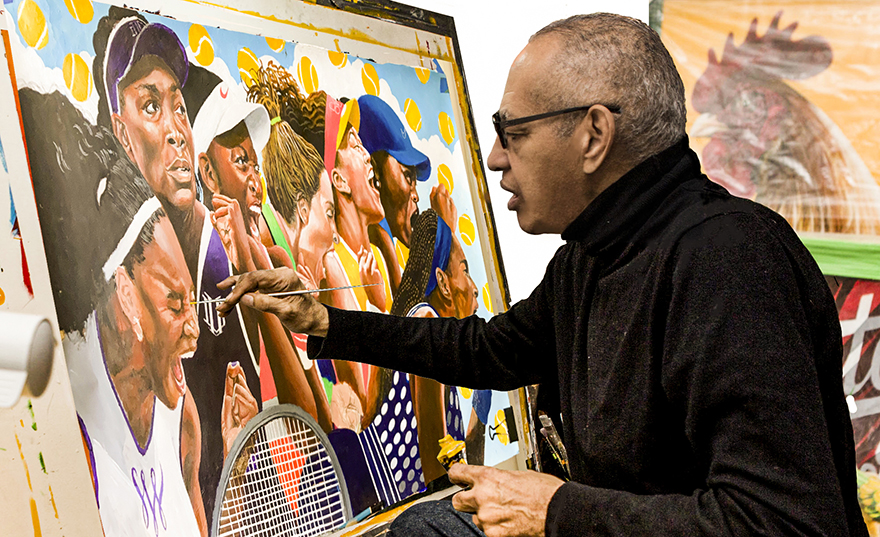
Chicago-based artist Joseph C.Randall, 78, is fluent in mixed media arts, including abstract realism.His work often prioritizes Black and African subjects, inviting the viewer to interrogate the long invalidated histories of marginalized groups.
Learn more about Joseph C.Randalls artistry below.How did your passion for art begin? I had the skill to draw as a child, but had no passion to make it a career.I attended the School of Visual Arts in New York, not for art, but for advertising.
Id been in advertising for 50 years, exploring drawing, creative concept development, and having operated my own ad agency.Did you enter the art world later in life? It was 2008, when I decided to pursue a second career in art.Although I still created ads and T.V.commercials for clients, I gradually shifted from advertising to creating mixed media artwork.
I wouldnt quit the advertising world until 2017.Before coming to Chicago, I worked mainly with oils.However now, I work in acrylics, mostly with colored pencils, a mix of media.I had my first one-man art exhibition on February 4, 2011, in Oak Park, Illinois, called From Ads 2 Art: The Transformation Exhibition on a cold, snowy Friday night.
More than fifty people attended and I sold sold three art pieces that evening!What inspired your newest work In The Spirit Of The Vaqueros!?I want my art to be interactive, emotive to the viewer, capturing the intimacy of the human spirit.In The Spirit Of The Vaqueros, (at left) the inspiration for this art was the fact that the word cowboy was a word used to describe White men on horses, and not Mexicans, Black or Native Americans.They were called vaqueros, they were among the most accomplished of all horsemen, vaqueros were masters of the rope.My artwork depicts a grandson with his grandfather in front of a backdrop of stabled horses as the boy reacts to a passing bird.
It represents a moment of bonding.My work explores the African Diaspora, Americas, Caribbean.What specific artists or themes consistently influence your work? I grew up on the works of Charles White, his work is powerfully expressive themes and Aaron Douglass, inducement of geometric designs into his canvas landscapes.I also admire the skill and visions of the current crop of fine artists such as; Kehinde Wiley, Thomas Blackshear and Shawn Michael Warren.What do you aim to achieve through your work? Specifically illuminating subjects of the African Diaspora?I want to illuminate the voices from the voiceless and underscore the brutality they suffered.
These are educational and artistic pieces.I want others to learn about and appreciate the history of Black and Brown folks.To this end, one of my latest art works is called Queen Melon (below, right), which interprets the history of a stereotype with a positive narrative of the almighty watermelon!In the scorching heat of the dry fields, where slaves tirelessly worked to gather crops like cotton, rice, and tobacco, the watermelon played a crucial role in sustaining them.
With its antioxidant-rich properties surpassing those of other fruits and vegetables, even tomatoes, the watermelon became a source of strength.Each day, from sunrise to sunset, the refreshing and succulent fruit empowered the enslaved individuals, offering them the resilience needed to endure the challenges they faced.I seek to interpret Black and Brown lifestyles and capture how we live each and every day; how we can enhance the quality of our lives through art.To see more of Joseph C.Randalls work, visit Instagram: _@josephcrandallart or visit his Facebook page.What challenges have you experienced as an artist?There are museums and galleries that often push more contemporary, younger artists, especially to appeal to younger audiences, overlooking older artists.
Artists are not eager to share their knowledge and there is perpetual gatekeeping.And a lot of the Black galleries, specifically in Chicago have not accepted my work.Theres a bigger question of what will generate capital, especially when an artist pays 30/60 split to venues and galleries.This system may not necessarily be in the best interest of the artist.Interpret Aging with Attitude in the context of your art.
What does this mean to you? Ive always been persistent.I was a member of C.O.R.E.and NAACP Youth & College Division, was at the March On Washington in 1963 and at the Poor Peoples March in 1968.I continue to persist despite the barriers in front of me.
I protest and resist quietly.Photo (Top) Reginald Payton, PhotographerAll others: Joseph C.RandallNaBeela Washington, an emerging Black writer, holds a Masters in Creative Writing and English from Southern New Hampshire University and Bachelors in Visual Advertising from The University of Alabama at Birmingham.She has been published in Eater, The Cincinnati Review, and others.
Learn more at nabeelawashington.com.
Publisher: Senior Planet ( Read More )

